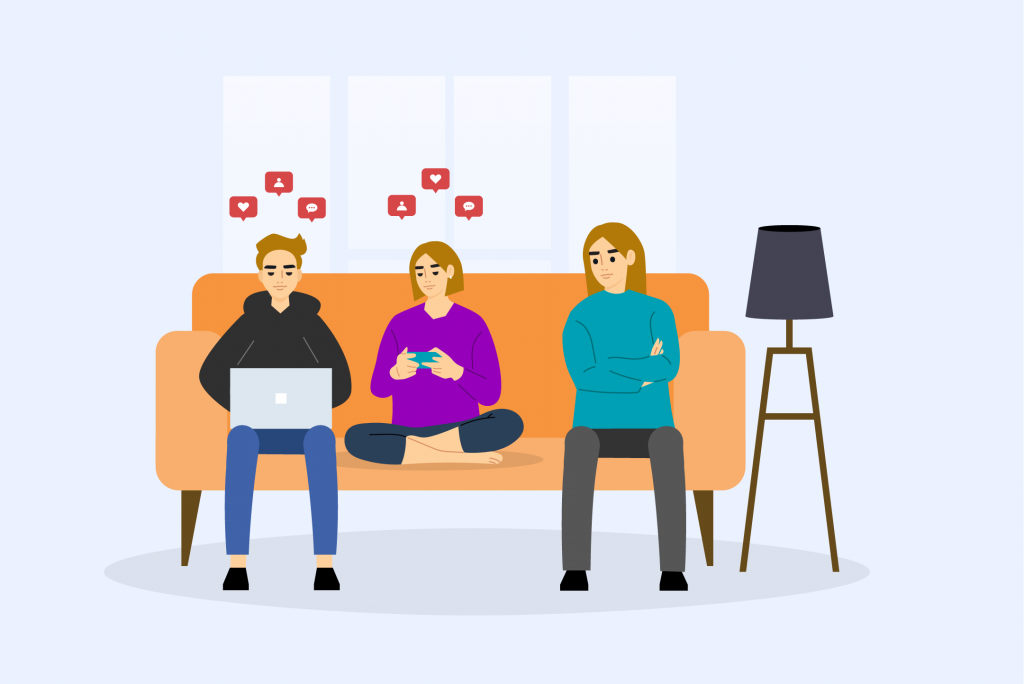LEARN MORE
JUNE 2024
Teens, tweens and social media: the good, the bad and how to make the best of it
Social media has become a part of daily life for most Americans. It’s the same for teens and tweens. Up to 95% report using a social media platform, with almost a third saying they use social media “almost constantly”.
While we’ve all read about cyberbullies and other online threats, social media can also give teens a sense of community, acceptance and belonging. This begs the question: Is social media good or bad for our teens?
Looking for more? Find other articles below

The good parts

Connection
In a 2018 Pew survey, 81% of teens said that social media helped them stay connected to their friends. 69% felt it allowed them to interact with a more diverse group of people. 68% said they found people online who would support them through tough times.

Self-expression and personal growth
Social media can help teens express themselves and teach them new skills. It exposes them to more perspectives and opinions. It makes sharing information easier. And it can provide teens with support from other people with whom they have hobbies or experiences in common.

Support for mental health
Anxious teens may find connecting online easier than in-person meetings, alleviating their loneliness. Teens who belong to groups that often get marginalized may find their tribe using social media. Social media that’s humorous or distracting can help a stressed teen cope with a challenging day.

Relationship-building
Some young people use social media to “build their brand” for social, school or business ventures. From reselling clothing or crafts on sites such as Depop or Etsy, to building a following for passion projects, such as car restoration, a social media presence can be a key tool for success.
The bad parts

Highly addictive
Because social media is designed to keep users coming back for more, it can be very addictive to the teenage brain. Adolescence is a period of significant brain development, making teenagers especially vulnerable to the built-in immediate gratification of shares, “likes,” comments and followers — especially since social media is always “on”.
In addition, emerging research suggests that short-form videos, such as those on TikTok and Instagram, are shortening attention spans. This can increase stress levels and interfere with school performance.

Sleep deprivation
According to the Centers for Disease Control, more than 70% of high schoolers don’t get enough sleep. Staying up late scrolling social media can contribute. Adolescents who don’t get enough sleep have a higher risk of obesity, diabetes, injuries, poor mental health and problems with attention and behavior.

Negative self-image and poor mental health
Social media is full of carefully crafted and filtered profiles. The perfect look and life of their favorite influencer can encourage teens and tweens to have unrealistic expectations. This can lead to body image concerns, eating disorders and poor self-esteem.
Cyberbullying can be even more severe than in-person bullying. Abusive messages or images can be sent anonymously, shielding perpetrators from consequences. Plus, by posting pictures of themselves, teens may unwillingly open themselves up to vicious comments and unwanted shares. Teens may find it hard to escape this form of bullying since rumors can spread farther, faster and be around for a long time.
In addition, the pressure to stay on top of the latest trends and opportunities can increase stress associated with FOMO (fear of missing out). Research has found that teens who spend more than three hours a day on social media face double the risk of experiencing symptoms of depression and anxiety.
If your teen is struggling with any of these issues, Brightline’s* expert therapists, psychiatrists and coaches provide help for sleep issues, cyberbullying, poor body image, ADHD, depression and anxiety.

Oversharing and regret
With the teenage brain, it’s common to make a choice before thinking it through. Teens might post something when they’re angry or upset and regret it later. Or share things that they’re not supposed to. This can be embarrassing and bring unwanted attention far beyond their close friend group.
5 ways to keep your teen in the good zone
So how can you try to ensure that your teen stays safe and has more positive experiences on social media? These 5 simple tips can help.

Talk about it
Check in with your teen about how social media’s working for them right now. Let them share their feelings about the time they spend on Instagram or Snapchat. Ask them what they find interesting and, if possible, suggest activities they could do to support that interest. If you’re concerned that your teens can’t control their social media use, talk about your concerns in a nonjudgmental way. Give your teens a chance to share their perspective on what they think could improve their experience.

Set a good example
It’s easy to jump on your phone to catch up on things when you get home from work. But remember, your behaviors are a model for your kids. When they’re talking to you, put your phone down. Make it a rule that everyone turns their phone off at mealtime. Be thoughtful about what you share on your own social media accounts and don’t post when you’re angry or upset. Show your kids that they control their social media use, it doesn’t control them.

Avoid toxicity
Discourage your teens from friending just anyone or engaging with people whose behavior is hurtful, demeaning or toxic. Rather than telling them who to connect with and who to avoid, share your own experiences with friends, both good and bad, to show that you can relate. Do your best to be non-judgmental and empathetic. And let your teens know they can always talk to you if they are worried about social media interactions that can be harmful to themselves or others.

Urge them to stay grounded
If your teens are seeing things on social media that make them feel like they don’t measure up, point out that not everything they see is real. The opposite is true, too — if they’re racking up likes for their social media persona, remind them that their real self is great, too. Either way, champion the idea of cultivating some screen-free time so they can stay in touch with who they are in real life.

Set boundaries
Remember, you know your kid best. If social media seems to make them feel worse, not better, about themselves, or you’re concerned about the amount of time they spend online, setting limits as a family could help. RethinkCare’s podcast Screen time, video games and social media can give you some ideas.
If you or your tween or teen could benefit from some extra support navigating social media, ask for help. Start by learning more about the resources below.
Sources:
Brightline. 5 tips to keep social media from wrecking your kid’s self-esteem.
Brightline. What to do when your kid is on social media all the time.
U.S. Department of Health and Human Services. Social media and youth mental health.
Mayo Clinic. Teens and social media: what’s the impact?
Centers for Disease Control. Sleep and health.
*Available only on the mainland.
Resources for you
- Brightline offers coaching and digital resources to support you and your tween or teen in managing social media use. This program is available to you and your children ages 0-18 who are covered by an Aetna medical plan. Visit HelloBrightline.com/Costco or call 888-224-7332 to learn more.
- RethinkCare gives parents and caregivers access to tools and resources to help their teens, tweens and children of any age manage challenges at home and at school. Once you register for this no-cost program, you also have access to monthly parent discussion groups to help you handle parenting challenges. To learn more, visit Connect.RethinkCare.com/sponsor/Costco or call 800-714-9285.
- Talkspace offers access to confidential, on-demand text therapy or video chat with a licensed therapist for teens age 13+ and adults. The first six sessions are free to you, your household members and dependent children up to age 26. Learn more at RFL.com/Costco or call 833-721-2320 (TTY: 711).
- RethinkCare gives parents and caregivers access to tools and resources to help their teens, tweens and children of any age manage challenges at home and at school. Once you register for this no-cost program, you also have access to monthly parent discussion groups to help you handle parenting challenges. To learn more, visit Connect.RethinkCare.com/sponsor/Costco or call 800-714-9285.
- Talkspace offers access to confidential, on-demand text therapy or video chat with a licensed therapist for teens age 13+ and adults. The first six sessions are free to you, your household members and dependent children up to age 26. Learn more at RFL.com/Costco or call 833-721-2320 (TTY: 711).
- RethinkCare gives parents and caregivers access to tools and resources to help their teens, tweens and children of any age manage challenges at home and at school. Once you register for this no-cost program, you also have access to monthly parent discussion groups to help you handle parenting challenges. To learn more, visit Connect.RethinkCare.com/sponsor/Costco or call 800-714-9285.
- Talkspace offers access to confidential, on-demand text therapy or video chat with a licensed therapist for teens age 13+ and adults. The first six sessions are free to you, your household members and dependent children up to age 26. Learn more at RFL.com/Costco or call 833-721-2320 (TTY: 711).

